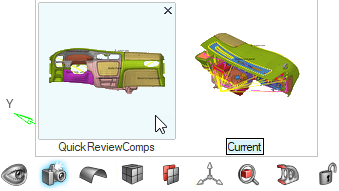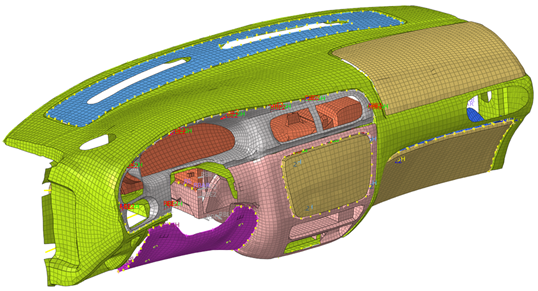Risk Analysis and Basic Screening
Use SnRD to identify Squeak and Rattle issues.
Risk Analysis & Basic Screening use case describes the basic screening analysis that the S&R analyst would perform. Starting from a NVH FE-model, built for other purposes, the analyst wants to define a first set of E-lines to assess the S&R performance of a system. Typically, this first analysis will occur at the early stage of the virtual development process, thus a lack of input might be a road blocker for the S&R CAE engineer. Therefore, the SnRD simple process will close this gap by offering automation and a set of default settings enabling this first analysis.
- Interface to be analyzed
- Dimensions and properties
- Loading Conditions
- Create FE model prepared for analyzing Squeak and Rattle
- Create Rattle E-Lines using Auto method.
- A SineSweep loadcase, with user settings.
- Run analysis, create summary page and export PPT report.
- Clean FE model- no SnRD information.
%20Analysis%20-%20Basic-Quick.png) Figure 1.
Figure 1. - Import tutorial model
- Define Interfaces.
- Create Evaluation Lines at interfaces.
- Create SineSweep based Dynamic event and export solver deck.
- Solve the
.FEMsolver deck to obtain results and files.
- Solve the
- Use the solver deck, E-Lines definition file and to post
process results.
- Generate histograms, contour plots, etc.
- Generate PPT report HyperWorks Report tool.
Files Required
Files required to complete the usecase.
Step 1: Import Model
Below are the steps to import files model, DTS and material files:
Step 2: Define the Interface Between Components by Creating Geometric Lines
Create geometric lines which will be used to define the interfaces to evaluate.
Create Geometric Lines
Use Create Geometric Lines tool to create geom lines in the model.
Step 3: Create E-Lines
Create and Manage all the E-Lines in the model.
Create E-Lines
Realize All E-Lines
Manage E-Lines
Step 4: SineSweep Loadcase Setup and Export OptiStruct File
Setup a SineSweep Loadcase and export the solver file. Solve the file using OptiStruct to obtain output files.
SineSweep Loadcase Setup
Export OptiStruct Solver File
.FEM solver deck
to solve on OptiStruct solver. Once done, two output files are generated:
.H3D and .PCH. These files will be used in
the Post Processing of results.Step 5: Risk Assessment
Evaluate risks for Squeak and Rattle with the Risk Assessment tool.
Step 6: Generate Summary Report
Export a Squeak and Rattle summary report using HyperWorks Report tool.

 option, select
option, select


 to open advanced options.
to open advanced options. 



 .
.















